What We’re Reading: December 14th
Opinion: A canopy conundrum: can wind-induced movement help to increase crop productivity by relieving photosynthetic limitations? ($)
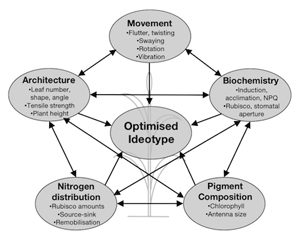 High wind speeds may result in substantial damage to crop canopies, resulting in a loss of productivity. Lower wind speeds affect crop canopies in different ways – while physical damage does not occur, the movement of plant tissues impacts photosynthetic capacity by altering the light environment, particularly at lower levels of the canopy. Assessing the role of low wind speeds in canopy photosynthesis is highly complex, as both the wind and the canopy response to wind are dynamic in time and space. In this Opinion paper, Burgess et al discuss the challenges associated with assessing the impact of wind on canopy photosynthesis. The authors consider the best way of measuring canopy movement in the field, and how wind-induced movement alters the light environment throughout the canopy. They then review the impact of this on rubisco activation and maintenance of photosynthetic capacity. There is a discussion of how best to integrate wind effects into dynamic computer models of photosynthesis, and the authors finish by assessing whether changing the canopy response to wind could help improve photosynthesis. (Summary by Mike Page) J Exp Bot 10.1093/jxb/ery424
High wind speeds may result in substantial damage to crop canopies, resulting in a loss of productivity. Lower wind speeds affect crop canopies in different ways – while physical damage does not occur, the movement of plant tissues impacts photosynthetic capacity by altering the light environment, particularly at lower levels of the canopy. Assessing the role of low wind speeds in canopy photosynthesis is highly complex, as both the wind and the canopy response to wind are dynamic in time and space. In this Opinion paper, Burgess et al discuss the challenges associated with assessing the impact of wind on canopy photosynthesis. The authors consider the best way of measuring canopy movement in the field, and how wind-induced movement alters the light environment throughout the canopy. They then review the impact of this on rubisco activation and maintenance of photosynthetic capacity. There is a discussion of how best to integrate wind effects into dynamic computer models of photosynthesis, and the authors finish by assessing whether changing the canopy response to wind could help improve photosynthesis. (Summary by Mike Page) J Exp Bot 10.1093/jxb/ery424
Special Issue – Plant Biotechnology, focus on lignin (Curr Opin Biotechnol) ($)
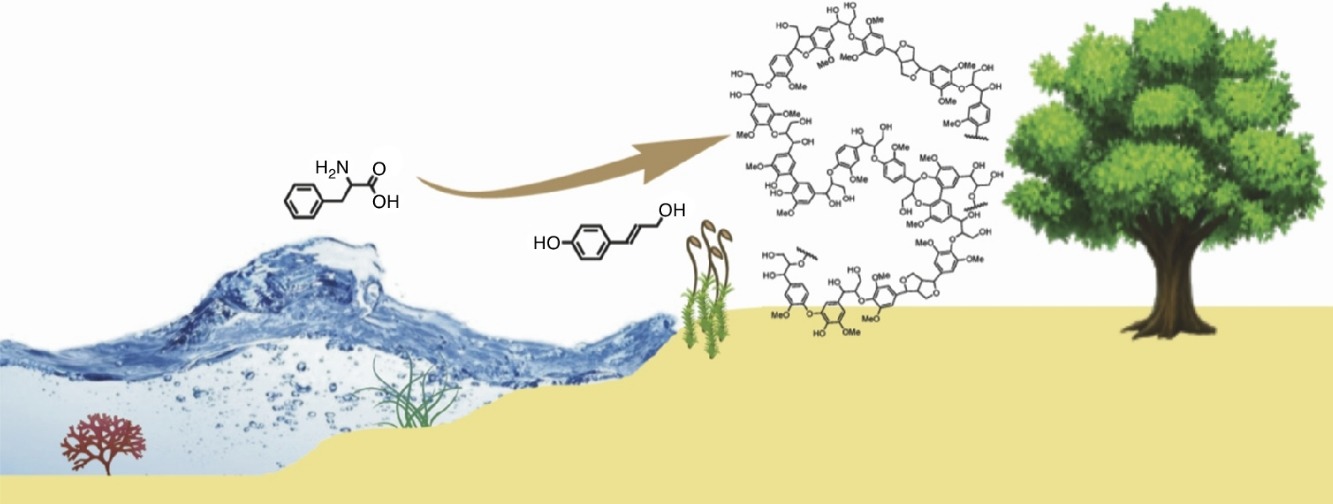 A forthcoming issue of Current Opinion in Biotechnology features a set of reviews on the topic of lignin, particularly its chemistry and applications. Lignin is a complex set of polymers that provide structural support to vascular plants (See Renault et al. for insights into lignin’s evolutionary origins). From a biochemical perspective, lignin is interesting because the polymerization of its monomers occurs non-enzymatically (see Perkins et al.; Tobimatsu and Schuetz; and Terette and Dupree). As a consequence, lignin is hugely diverse, with structural properties that vary with its species and site of origin (see Barbosa et al.). Lignin is also industrially very important. Although indepsensible for the strength of wood, it gets in the way of the production of other plant-derived materials. For example, lignin must be removed to isolate cabohydrate-based cell walls for pulp, paper and biofuel production. However, the extracted lignin itself can be used for energy production and as a source for biopolymers and nanomaterials (see Grossman and Vermerris; and Kamimura et al.). Efforts are also underway to further our understanding of lignin synthesis and function in planta, in part with the objective to alter lignin production in planta for enhanced biofuel production and improved digestibility of forage for animals (See Ohtani and Demura; Vanholme et al.; Mahon and Manfield; and Barros et al.). This is a super collection of articles featuring this very special polymer. (Summary by Mary Williams) Curr. Opin. Biotechnol. April 2019.
A forthcoming issue of Current Opinion in Biotechnology features a set of reviews on the topic of lignin, particularly its chemistry and applications. Lignin is a complex set of polymers that provide structural support to vascular plants (See Renault et al. for insights into lignin’s evolutionary origins). From a biochemical perspective, lignin is interesting because the polymerization of its monomers occurs non-enzymatically (see Perkins et al.; Tobimatsu and Schuetz; and Terette and Dupree). As a consequence, lignin is hugely diverse, with structural properties that vary with its species and site of origin (see Barbosa et al.). Lignin is also industrially very important. Although indepsensible for the strength of wood, it gets in the way of the production of other plant-derived materials. For example, lignin must be removed to isolate cabohydrate-based cell walls for pulp, paper and biofuel production. However, the extracted lignin itself can be used for energy production and as a source for biopolymers and nanomaterials (see Grossman and Vermerris; and Kamimura et al.). Efforts are also underway to further our understanding of lignin synthesis and function in planta, in part with the objective to alter lignin production in planta for enhanced biofuel production and improved digestibility of forage for animals (See Ohtani and Demura; Vanholme et al.; Mahon and Manfield; and Barros et al.). This is a super collection of articles featuring this very special polymer. (Summary by Mary Williams) Curr. Opin. Biotechnol. April 2019.
Review: Nicotiana benthamiana: a workhorse of model plants
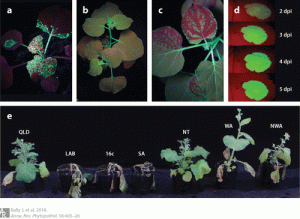 For years, scientists have relied on model species to investigate the fundamental nature of plants. Not surprisingly, these systems have facilitated our combined efforts for a deeper understanding of complex plant phenomena, from the coordinated orchestration of developmental programs to the emerging interconnected networks controlling responses to stressful stimuli. In an insightful review now published in Annual Review of Phytopathology (2018), Bally et al. provide an evolutionary and historical perspective on the ever-popular model angiosperm Nicotiana benthamiana. The authors discuss both historical and modern applications of this Solanaceous powerhouse of a model system, which is native only to Australia yet can be found in laboratories and glasshouses across the globe. Moreover, the authors describe the current and future perspective of N. benthamiana as a viable system in industrial as well as academic settings, making this review a must-read for any and all scientists currently benefiting from this multi-purpose powerhouse plant. (Summary by Phil Carella) Annu. Rev. Phytopathol. 10.1146/annurev-phyto-080417-050141
For years, scientists have relied on model species to investigate the fundamental nature of plants. Not surprisingly, these systems have facilitated our combined efforts for a deeper understanding of complex plant phenomena, from the coordinated orchestration of developmental programs to the emerging interconnected networks controlling responses to stressful stimuli. In an insightful review now published in Annual Review of Phytopathology (2018), Bally et al. provide an evolutionary and historical perspective on the ever-popular model angiosperm Nicotiana benthamiana. The authors discuss both historical and modern applications of this Solanaceous powerhouse of a model system, which is native only to Australia yet can be found in laboratories and glasshouses across the globe. Moreover, the authors describe the current and future perspective of N. benthamiana as a viable system in industrial as well as academic settings, making this review a must-read for any and all scientists currently benefiting from this multi-purpose powerhouse plant. (Summary by Phil Carella) Annu. Rev. Phytopathol. 10.1146/annurev-phyto-080417-050141
The role of ER stress-depending autophagy under phosphate deprivation
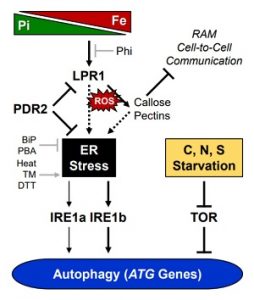 In the Brassicaceae, inorganic phosphate (Pi) deprivation modifies root system architecture to favor Pi foraging, through the inhibition of primary root growth and the stimulation of lateral root growth. Root growth inhibition is triggered by Fe-stimulated ROS generation and cell wall modifications, which cause ER stress and could induce autophagy. Autophagy is a process that has been studied under other nutrient starvation stressors (carbon, nitrogen and sulfur) but not Pi deprivation. Naumann and colleagues studied the effect of Pi deprivation in autophagy using a variety of Arabidopsis mutants. They found that ER stress-dependent autophagy is quickly activated in response to Pi limitation in roots, and this activation requires the genetic PDR2 (ER-resident P5-type ATPase)-LPR1 (cell-wall-target ferroxidase) module. Thus, the root-localized Pi-dependent activation of autophagy is due to local Pi sensing and related ER stress responses. (Summary by Julia Miller) Plant Physiol. 10.1104/pp.18.01379
In the Brassicaceae, inorganic phosphate (Pi) deprivation modifies root system architecture to favor Pi foraging, through the inhibition of primary root growth and the stimulation of lateral root growth. Root growth inhibition is triggered by Fe-stimulated ROS generation and cell wall modifications, which cause ER stress and could induce autophagy. Autophagy is a process that has been studied under other nutrient starvation stressors (carbon, nitrogen and sulfur) but not Pi deprivation. Naumann and colleagues studied the effect of Pi deprivation in autophagy using a variety of Arabidopsis mutants. They found that ER stress-dependent autophagy is quickly activated in response to Pi limitation in roots, and this activation requires the genetic PDR2 (ER-resident P5-type ATPase)-LPR1 (cell-wall-target ferroxidase) module. Thus, the root-localized Pi-dependent activation of autophagy is due to local Pi sensing and related ER stress responses. (Summary by Julia Miller) Plant Physiol. 10.1104/pp.18.01379
Genomic diversification of LATE EMBRYOGENESIS ABUNDANT (LEA) protein gene families
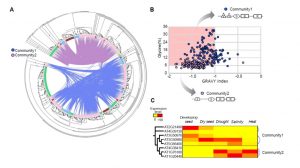 LEA genes were first identified as being highly abundant during seed desiccation (hence their name), but later were also shown to accumulate in other tissues in response to drought stress, and to confer desiccation tolerance in “resurrection plants”. These small proteins are characterized by having intrinsically disordered domains, shown to contribute to their properties of protecting macromolecular structures. LEA proteins are encoded by eight multi-gene families, raising questions about evolutionary origins and functional redundancies. Artur et al. explored LEA genes across 60 complete plant genomes, including desiccation tolerant angiosperms, nonvascular plants and green algae. Their findings suggest that two gene families predate terrestrial plants, but there has been extensive amplification in the terrestrial lineages, leading to diverse functions and expression patterns. Synteny analysis of LEA genes indicates that genes that are retained in chromosomal position across plant lineages are likely to have conserved function, and that synteny diversification is often correlated with functional diversification. (Summary by Mary Williams) Genome Biology and Evolution 10.1093/gbe/evy248.
LEA genes were first identified as being highly abundant during seed desiccation (hence their name), but later were also shown to accumulate in other tissues in response to drought stress, and to confer desiccation tolerance in “resurrection plants”. These small proteins are characterized by having intrinsically disordered domains, shown to contribute to their properties of protecting macromolecular structures. LEA proteins are encoded by eight multi-gene families, raising questions about evolutionary origins and functional redundancies. Artur et al. explored LEA genes across 60 complete plant genomes, including desiccation tolerant angiosperms, nonvascular plants and green algae. Their findings suggest that two gene families predate terrestrial plants, but there has been extensive amplification in the terrestrial lineages, leading to diverse functions and expression patterns. Synteny analysis of LEA genes indicates that genes that are retained in chromosomal position across plant lineages are likely to have conserved function, and that synteny diversification is often correlated with functional diversification. (Summary by Mary Williams) Genome Biology and Evolution 10.1093/gbe/evy248.
Stomatal closure requires jasmonate-mediated activation of K+ channels by a CBL/CIPK kinase complex
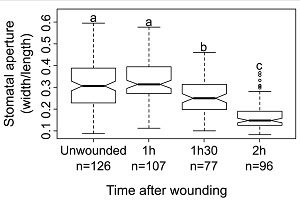 Guard cells control gas exchange and transpiration by responding to environmental stimuli and hormonal signals. The hormones jasmonic acid (JA) and abscisic acid (ABA) both induce stomatal closure. However, while the molecular mechanisms of ABA signaling in guard cells has largely been elucidated, the mechanisms of JA signaling remain mostly unknown. Förster and colleagues use Arabidopsis, yeast and electrophysiological experiments to identify a fast JA signaling pathway that targets the K+ efflux channel GORK. Wounding triggers stomatal closures and JA signaling cascades, which results in GORK being phosphorylated by CBL1-CIPK5 Ca2+ sensor-kinase complexes. The authors also found that GORK activation depends on plasma membrane targeting and CBL1-CIPK5 complexes binding Ca2+. Additionally, the ABA co-receptor ABI2 was found to counteract CBL1-CIPK5-dependent GORK activation. Thus, JA-induced calcium signaling can be integrated with ABA-mediated drought signaling to facilitate GORK-mediated stomatal closure. (Summary by Julia Miller) Devel. Cell 10.1016/j.devcel.2018.11.014
Guard cells control gas exchange and transpiration by responding to environmental stimuli and hormonal signals. The hormones jasmonic acid (JA) and abscisic acid (ABA) both induce stomatal closure. However, while the molecular mechanisms of ABA signaling in guard cells has largely been elucidated, the mechanisms of JA signaling remain mostly unknown. Förster and colleagues use Arabidopsis, yeast and electrophysiological experiments to identify a fast JA signaling pathway that targets the K+ efflux channel GORK. Wounding triggers stomatal closures and JA signaling cascades, which results in GORK being phosphorylated by CBL1-CIPK5 Ca2+ sensor-kinase complexes. The authors also found that GORK activation depends on plasma membrane targeting and CBL1-CIPK5 complexes binding Ca2+. Additionally, the ABA co-receptor ABI2 was found to counteract CBL1-CIPK5-dependent GORK activation. Thus, JA-induced calcium signaling can be integrated with ABA-mediated drought signaling to facilitate GORK-mediated stomatal closure. (Summary by Julia Miller) Devel. Cell 10.1016/j.devcel.2018.11.014
Pseudogenization and resurrection of a speciation gene
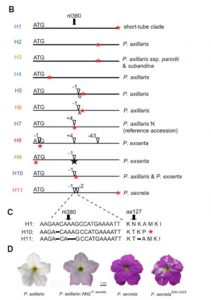 Many flowers have evolved to attract pollinators through scent, shape, nectar production and color. Small changes in any of these attributes can be sufficient to dramatically shift pollinator preferences and pollination efficiency. Petunia has recently diverged into several species, characterized as short- or long-tube forms. Short tube forms are purple and bee-polinated, whereas there is more diversity in the long-tube forms. Petunia axillaris is a white long-tube form, pollinated by hawk moths, and with a loss-of function single nucleotide deletion in a gene encoding the AN2 transcription factor involved in expression of pigment genes. Another long-tube form Petunia secreta, is purple. Using phylogenetic reconstructions, sequence comparisons, and functional analyses, Esfeld et al. showed that P. secreta is derived from P. axillaris by an additional two-nucleotide deletion in the gene encoding AN2, restoring the proper reading frame and thus a functional protein (and pigmentation). Thus, they have demonstrated the rather improbably resurrection of a key speciation gene. (Summary by Mary Williams) Curr. Biol. 10.1016/j.cub.2018.10.019
Many flowers have evolved to attract pollinators through scent, shape, nectar production and color. Small changes in any of these attributes can be sufficient to dramatically shift pollinator preferences and pollination efficiency. Petunia has recently diverged into several species, characterized as short- or long-tube forms. Short tube forms are purple and bee-polinated, whereas there is more diversity in the long-tube forms. Petunia axillaris is a white long-tube form, pollinated by hawk moths, and with a loss-of function single nucleotide deletion in a gene encoding the AN2 transcription factor involved in expression of pigment genes. Another long-tube form Petunia secreta, is purple. Using phylogenetic reconstructions, sequence comparisons, and functional analyses, Esfeld et al. showed that P. secreta is derived from P. axillaris by an additional two-nucleotide deletion in the gene encoding AN2, restoring the proper reading frame and thus a functional protein (and pigmentation). Thus, they have demonstrated the rather improbably resurrection of a key speciation gene. (Summary by Mary Williams) Curr. Biol. 10.1016/j.cub.2018.10.019
Synthetic apomixis: Asexual propagation through seeds ($)
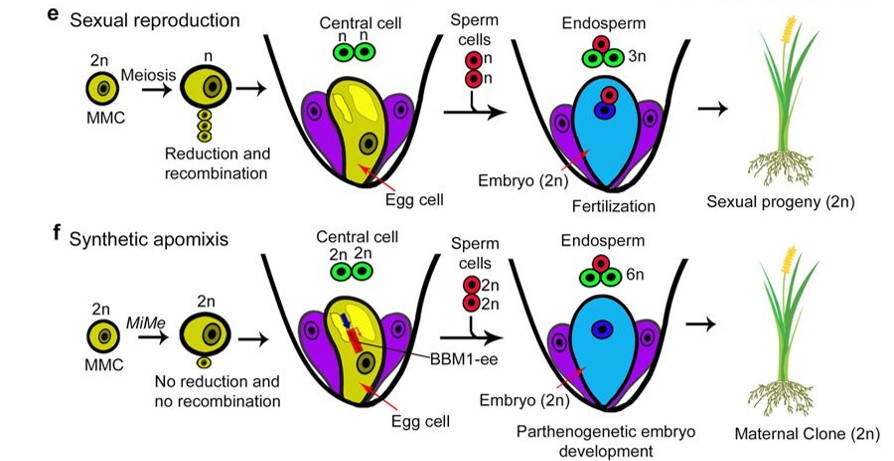
Sexual reproduction mixes up genes and provides genetically diverse progeny, key for survival and fodder for evolution. Sexual reproduction is detrimental to the propagation of hybrid crops though, as mixing up the genes leads to progeny that will be inferior to the hybrid parent. Khanday et al. have developed an asexual-propagation trait that allows a hybrid plant to reproduce clonally, with the progeny also carrying the desirable genome-wide heterogeneity. They accomplish this by silencing genes encoding the BABYBOOM transcription factor (BBM1-3) and introducing a BBM1 gene expressed solely in the egg cell. This leads to embryo development in the abscence of fertilization and clonal progeny, although seed production still requires fertilization to generate the endosperm. This work, which builds on previous studies that have shown the capacity of BBM1 to induce somatic embryos from vegetative tissues, shows that seed propagation from hybrid rice varieties can occur without genetic segregation. (Summary by Mary Williams) Nature 10.1038/s41586-018-0785-8 A different strategy was used towards the same end in a new preprint by Wang et al. See
A key role for flavanols in the promotion of pollen success
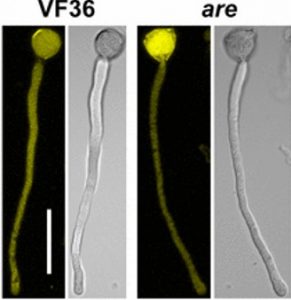 The reproductive success of angiosperms relies on the fertilization of the female gametophyte (egg sac) by pollen that travels long-distances in the pistil. Previous studies suggest a role for phenylpropanoid-related metabolites (flavonoids and anthocyanins) in controlling pollen growth and fertilization, however a mechanistic understanding of their function during this critical developmental process remains unknown. In a recent study published in PNAS (2018), Muhlemann et al. demonstrate the protective capacity of flavonols on pollen tube functionality under normal and heat-stressed conditions. Using a tomato mutant defective in anthocyanin accumulation, anthocyanin reduced (are), the authors outline an important role for flavonols in pollen grain accumulation, viability, germination, and tube growth within the pistil. Histochemical stains revealed the interplay between flavonol and reactive oxygen species (ROS) accumulation in pollen tubes, such that reduced flavonol levels in are mutants were associated with increased levels of ROS. This suggested that the complement of pollen grain/tube flavonols are required to scavenge/mitigate the impact of ROS, an idea that was supported by the rescue of are pollen defects by anti-oxidative ROS scavenging chemicals. The inhibitory action of ROS on pollen functionality was exacerbated in plants experiencing heat stress, where stress-related ROS accumulation negatively impacted are mutants to a greater extent than wild-type controls. Collectively, this work identifies flavonols as key regulators of reproductive success that act to limit the negative impact of ROS accumulation in pollen tubes. (Summary by Phil Carella) Proc. Natl. Acad. Sci. USA
The reproductive success of angiosperms relies on the fertilization of the female gametophyte (egg sac) by pollen that travels long-distances in the pistil. Previous studies suggest a role for phenylpropanoid-related metabolites (flavonoids and anthocyanins) in controlling pollen growth and fertilization, however a mechanistic understanding of their function during this critical developmental process remains unknown. In a recent study published in PNAS (2018), Muhlemann et al. demonstrate the protective capacity of flavonols on pollen tube functionality under normal and heat-stressed conditions. Using a tomato mutant defective in anthocyanin accumulation, anthocyanin reduced (are), the authors outline an important role for flavonols in pollen grain accumulation, viability, germination, and tube growth within the pistil. Histochemical stains revealed the interplay between flavonol and reactive oxygen species (ROS) accumulation in pollen tubes, such that reduced flavonol levels in are mutants were associated with increased levels of ROS. This suggested that the complement of pollen grain/tube flavonols are required to scavenge/mitigate the impact of ROS, an idea that was supported by the rescue of are pollen defects by anti-oxidative ROS scavenging chemicals. The inhibitory action of ROS on pollen functionality was exacerbated in plants experiencing heat stress, where stress-related ROS accumulation negatively impacted are mutants to a greater extent than wild-type controls. Collectively, this work identifies flavonols as key regulators of reproductive success that act to limit the negative impact of ROS accumulation in pollen tubes. (Summary by Phil Carella) Proc. Natl. Acad. Sci. USA



